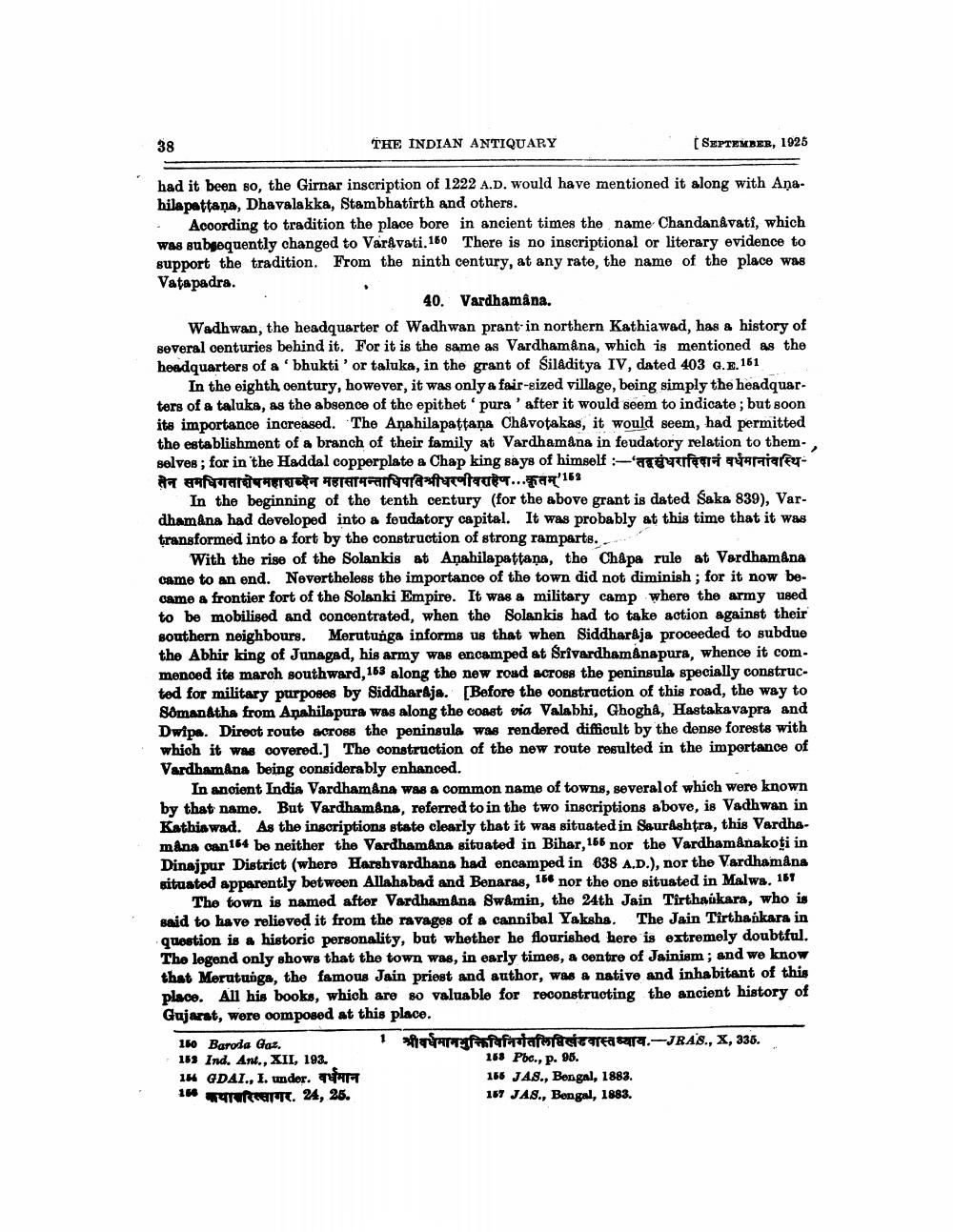________________
38
THE INDIAN ANTIQUARY
[ SEPTEMBER, 1926
had it been so, the Girnar inscription of 1222 A.D. would have mentioned it along with Anahilapattana, Dhavalakka, Stambhatírth and others. • Acoording to tradition the place bore in ancient times the name Chandanavati, which was subgequently changed to Varavati.160 There is no inscriptional or literary evidence to support the tradition. From the ninth century, at any rate, the name of the place was Vatapadra.
40. Vardhamâna. Wadhwan, the headquarter of Wadhwan prant in northern Kathiawad, has a history of several centuries behind it. For it is the same as Vardhamana, which is mentioned as the headquarters of a bhukti'or taluka, in the grant of Siladitya IV, dated 403 G. E. 161
In the eighth oentury, however, it was only a fair-sized village, being simply the headquarters of a taluka, as the absence of the epithet' purs' after it would seem to indicate; but soon its importance increased. The Anahilapattana Chavotakas, it would seem, had permitted the establishment of a branch of their family at Vardhamana in feudatory relation to them. selves; for in the Haddal copperplate a Chap king says of himself :-'
a v a Araruतेन समधिगताशेषमहाशब्देन महासामन्ताधिपतिश्रीधरणीवराहेण...कृतम्'118
In the beginning of the tenth certury (for the above grant is dated Saka 839), Vardhamana had developed into a feudatory capital. It was probably at this time that it was transformed into a fort by the construction of strong ramparts.
With the rise of the Solankis at Anahilapattana, the Ch&pa rule at Vardhamana came to an end. Nevertheless the importance of the town did not diminish ; for it now became a frontier fort of the Solanki Empire. It was a military camp where the army used to be mobilised and concentrated, when the Solankis had to take action against their southern neighbours. Merutunga informs us that when Siddhardja proceeded to subdue the Abhir king of Junagad, his army was encamped at Srivardhamanapura, whence it commenoed its march southward, 163 along the new road across the peninsula specially constructed for military purposes by Siddharája. [Before the construction of this road, the way to Soman&ths from Anahilapura was along the coast via Valabhi, Ghogha, Hastakavapra and Dwipa. Direot route across the peninsula was rendered difficult by the dense forests with which it was covered.) The construction of the new route resulted in the importance of Vardhamana being considerably enhanced.
In ancient India Vardhamana was a common name of towns, several of which were known by that name. But Vardhamana, referred to in the two inscriptions above, is Vadhwan in Kathiawad. As the inscriptions state clearly that it was situated in Saurashtra, this Vardhamáns can 164 be neither the Vardhamana situated in Bihar, 166 nor the Vardhamanakoti in Dinajpur District (where Harshvardhans had encamped in 638 A.D.), nor the Vardhamana situated apparently between Allahabad and Benaras, 166 nor the one situated in Malwa. 157
The town is named aftor Vardhamana Swamin, the 24th Jain Tirthaikara, who is said to have relieved it from tho ravages of a cannibal Yakshs. The Jain Tirthankara in question is a historio personality, but whether he flourished here is extremely doubtful. The legend only shows that the town was, in early times, a centre of Jainism ; and we know that Merutunga, the famous Jain priest and author, was a native and inhabitant of this place. All his books, which are so valuable for reconstructing the ancient history of Gujarat, were composed at this place. 150 Baroda Gaz.
1 Arafafafarlararae Tea 14.-JRAS., X, 336. 153 Ind. Ant., XII, 193.
168 Pbr., p. 96. 14 GDAI., 1. under.
166 JAS., Bongal, 1883. 16 Mrafeer. 24, 25.
167 JAN., Bongal, 1883.




